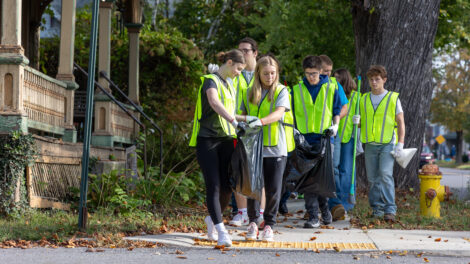Social workers, WASD district talk mental health needs of students
As schools return to all in-person learning after two years of dealing with pandemic mitigation efforts, what is emerging is the loss not only in terms of academic skills that students are experiencing but also a loss of the ability to connect on a social and emotional level.
“Mental health needs were on the rise prior to the pandemic, but the pandemic really exacerbated more,” said Heather Way, social worker in the Williamsport Area School District.
Although they do not diagnose, the counselors do refer and they have seen an increase in the need for referrals.
“We see that in our numbers daily with our referrals to support service, counseling, outside services and risk assessments,” she said.
“We’re seeing an increase in kids who need extra emotional support, behavioral support, things like that. I think we’re doing a pretty good job of trying to respond to that, to the best of our ability in terms of making sure that we’re increasing the resources that are available to kids,” said Megan Hunter, also a social worker in the district.
“All of our students have access to school-based therapy or it could be a referral to school-based therapy. As well as school-based therapy, depending on grade level and need, opportunities for therapeutic groups that are focused on different topics are available,” Way said.
One way to help students deal with these issues is through social emotional learning.
“What has become essential,” Way said, is “the need for social emotional learning, like equipping students with skills and knowledge and attitudes to assist them to become mindful, to be aware of even the fact that they have lost skills through that time.”
“Some of them might not even realize how many hours they’ve spent through a screen or through Zoom and not had this type of interaction that actually caused them to lose some of their ability to engage and engage well and know how to interact and make eye contact with a teacher,” she said.
Hunter elaborated on the subject.
“The various things that came up as a result of the pandemic — the loss of social interactions outside of the home, the increased screen time, the loss of community. Just any kind of community. People weren’t going to church. People weren’t going to their after-school programs or to school or things like that — definitely impacted. If we don’t have community then that’s definitely impacting our emotional health,” Hunter said.
Way, who works primarily with students in the lower grades, said that she has seen primary kids coming in who haven’t had preschool or haven’t had the opportunity to be in groups with other children. Because of the pandemic there are children in second grade who just had their first full year of school last year.
“You definitely see some delays in how they’re interacting with peers and the stress that can happen if they’re delayed in those areas. I do think that impacts them. That’s true for older kids as well. The older kids felt more of a loss. I think they had something that they no longer have,” Hunter said.
“Now they’re trying to get it back. You do see a significant difference in their skills just in terms of how they’re interacting interpersonally. How they’re able to manage stress and relationships with peers and things like that., primarily based on they haven’t had any practice for a while. They haven’t had the opportunities that they were having before…I think it had a really swift and profound impact on kids,” Hunter added.
If students are lacking in those skills, it also affects their ability to learn and to retrieve and retain what they have learned.
“So many people separate it from academic needs,” Way said, adding that it is important to meet the social and emotional needs of students in the learning process.
“The basis of it is this, social emotional learning is in place and being addressed in order for students to access academic learning,” said Dr. Brandon Pardoe, director of student services at the Williamsport Area School District.
He referred to Maslow’s hierarchy of needs, which says if a person’s basic physiological needs, such as food, clothing, sleep and shelter — the foundational needs — are not being met, that affects their ability to attain other things.
“You have to be stable in those areas in order to function as a human efficiently, productively, happily, all those things that are involved. The same can be said with academic learning in school,” he said.
“So, think about where we are right now coming off two and a half years of very different experience — a 100-year pandemic that nobody that I am aware of has experienced in a lifetime, until what we experienced in these last two and a half years,” Pardoe said.
The question that this curriculum addresses is, how can we expect students to learn if they’re not okay with the social and emotional aspects of that?
“What it is, it’s a level playing field where everybody’s getting that opportunity of instruction in that area by using the curriculum that’s in place in hopes of really allowing them to engage and access the academic learning that they’re presented during their time in school. Social emotional learning goes out into real life, real world experiences, the cognitive part of academic learning gets coupled by it, but how can we expect students to learn if they’re not okay socially and emotionally,” Pardoe said.
“It’s really maximizing that opportunity for them to be OK with themselves, OK with others, in order to learn,” he added.
Because of what has happened and is still happening, needs are different and greater than before the pandemic. The idea of stigmatizing seeking help goes out the window when there is such a great need by so many for some sort of treatment for mental health issues.
“I do see that there’s just a lot of opportunity and hopefully it is forcing us to shift the way we’ve always done things because the needs are different. We have to think differently and do differently because of what is currently happening. I hope that provides a lot of opportunity to function differently, see differently and for people to learn more, understand more why we’re seeing this. Be more empathetic towards one another because I think we do to some level now, still stigmatize,” Way said.
“My hope coming out of this is that the stigma goes down, because honestly, we have all struggled. We all continue to struggle and we’ve all needed help on some level. So, to break down those walls and barriers is the hope coming out of this,” she added.





